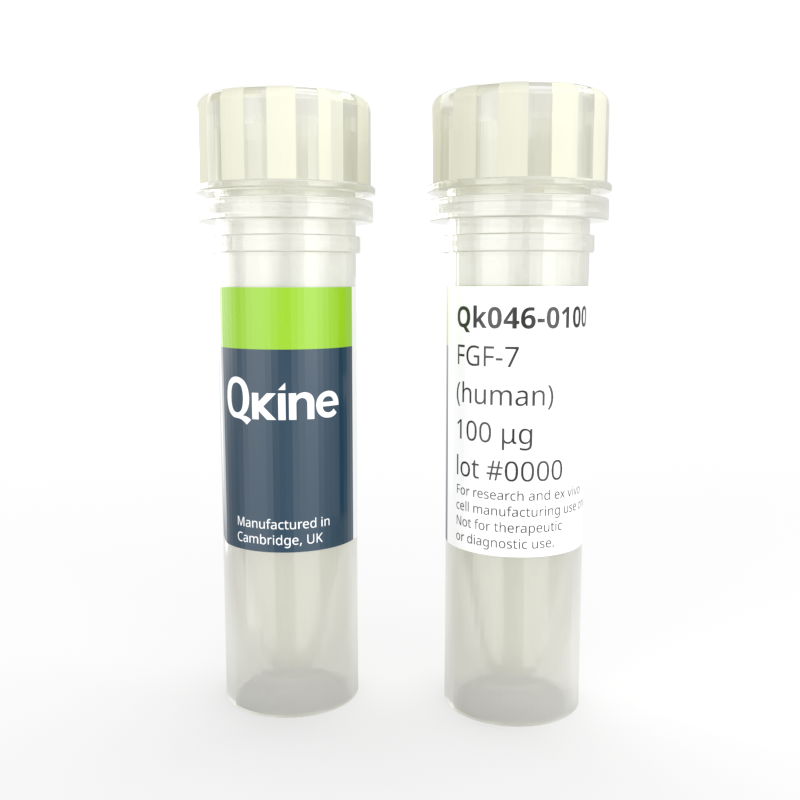Recombinant human KGF (FGF-7) protein
QK046
Brand: Qkine
Human KGF protein (FGF-7) is a member of the FGF family. Recombinant KGF protein is used in the culture of lung, breast, liver, and bladder organoids.
Qkine human KGF (FGF-7) is a highly pure and bioactive 19 kDa protein, animal-origin free (AOF) and carrier-protein free (CF).

Currency:
| Product name | Catalog number | Pack size | Price | Price (USD) | Price (GBP) | Price (EUR) |
|---|---|---|---|---|---|---|
| Recombinant human KGF (FGF-7) protein, 25 µg | QK046-0025 | 25 µg | (select above) | $ 355.00 | £ 255.00 | € 298.00 |
| Recombinant human KGF (FGF-7) protein, 50 µg | QK046-0050 | 50 µg | (select above) | $ 515.00 | £ 380.00 | € 444.00 |
| Recombinant human KGF (FGF-7) protein, 100 µg | QK046-0100 | 100 µg | (select above) | $ 760.00 | £ 560.00 | € 655.00 |
| Recombinant human KGF (FGF-7) protein, 500 µg | QK046-0500 | 500 µg | (select above) | $ 3,100.00 | £ 2,300.00 | € 2,687.00 |
| Recombinant human KGF (FGF-7) protein, 1000 µg | QK046-1000 | 1000 µg | (select above) | $ 4,950.00 | £ 3,600.00 | € 4,205.00 |
Note: prices shown do not include shipping and handling charges.
Qkine company name and logo are the property of Qkine Ltd. UK.
Alternative protein names
Species reactivity
Summary
- High purity KGF (FGF-7) protein (Uniprot: P21781)
- 19 kDa>98%, by SDS-PAGE quantitative densitometry
- Expressed in E. coli
- Animal origin-free (AOF) and carrier protein-free
- Manufactured in Qkine Cambridge, UK laboratories
- Lyophilized from PBS
- Resuspend in sterile-filtered water at >50 µg/ml, add carrier protein if desired, prepare single use aliquots and store frozen at -20 °C (short-term) or -80 °C (long-term).
Featured applications
Airway, mammary, liver hepatocyte, and urothelium organoids
Bioactivity
FGF-7 (KGF) activity is determined using the Promega serum response element luciferase reporter assay (*) in transfected MCF-7 cells. Cells are treated in triplicate with a serial dilution of KGF for 4 hours. Firefly luciferase activity is measured and normalized to the control Renilla luciferase activity. EC50 = 92 pM (1.75 ng/mL). Data from Qk046 lot #104314. *Promega pGL4.33[luc2P/SRE/Hygro] #E1340

Purity
KGF protein migrates as a monomer at 19 kDa and a dimer at 38 kDa in non-reducing (NR) conditions and 19 kDa upon reduction (R). No contaminating protein bands are visible. Purified recombinant protein (3 µg) was resolved using 15% w/v SDS-PAGE in reduced (+β-mercaptothanol, R) and non-reduced (NR) conditions and stained with Coomassie Brilliant Blue R250. Data from Qk046 lot #104314

Further quality assays
- Mass spectrometry: single species with expected mass
- Endotoxin: <0.005 EU/μg protein (below level of detection)
- Recovery from stock vial: >95%
Comparison with other suppliers

KGF (FGF-7) from Qkine (Qk046) and a major supplier have equivalent bioactivity. Qk046 KGF (FGF-7) lot #104425 and KGF from another supplier were compared in the same assay plate with EC50s of 2.0 ng/ml and 3.7 ng/ml respectively.
Protein background
Keratinocyte growth factor (KGF), also known as fibroblast growth factor-7 (FGF-7), is part of the large FGF family, and, alongside FGF-3, FGF-10, and FGF-22, is a member of the FGF-7 subfamily. This subfamily is secreted exclusively by the mesenchyme, and specifically activates the “b” isoforms of FGFR1 (FGFR1b) and FGFR2 (FGFR2b) present in the overlying epithelium [1], of these receptors KGF acts through the IIIb splice form of FGFR2. KGF is required for the development of the kidney, thymus, and hippocampus [2]. KGF also plays an import role in wound healing [3], a role exemplified in studies on bioengineered skin [3]. KGF protein has been used in generation of many organoids including lung, breast, liver and bladder [2].
Background references
- Zinkle, Allen, and Mohammadi, Moosa. ‘Structural Biology of the FGF7 Subfamily’. Frontiers in Genetics, vol. 10, 2019. Frontiers, doi:10.3389/fgene.2019.00102.
- Fujii, Masayuki, and Sato, Toshiro. ‘Somatic Cell-Derived Organoids as Prototypes of Human Epithelial Tissues and Diseases’. Nature Materials, vol. 20, no. 2, Feb. 2021, pp. 156–69. doi:10.1038/s41563-020-0754-0.
- Werner, Sabine, and Grose, Richard. ‘Regulation of Wound Healing by Growth Factors and Cytokines’. Physiological Reviews, vol. 83, no. 3, July 2003, pp. 835–70. doi:10.1152/physrev.2003.83.3.835
- Erdag, Gulsun, et al. ‘FGF-7 Expression Enhances the Performance of Bioengineered Skin’. Molecular Therapy, vol. 10, no. 1, July 2004, pp. 76–85. doi:10.1016/j.ymthe.2004.04.013.
Publications using recombinant human KGF (FGF-7) protein (Qk046)
Generation of human iPSC-derived pancreatic organoids to study pancreas development and disease
Darrigrand J-F, Isaacson A and Spagnoli FM
DOI: https://doi.org/10.1101/2024.10.24.620102